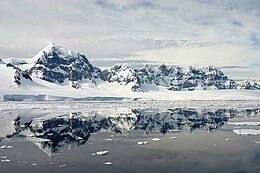Wiencke Island

Luigi peak, Fief Range, Wiencke Island
|
|
|
Location in Antarctica
|
|
| Geography | |
|---|---|
| Location | Antarctica |
| Coordinates | 64°50′S 63°23′W / 64.833°S 63.383°WCoordinates: 64°50′S 63°23′W / 64.833°S 63.383°W |
| Archipelago | Palmer Archipelago |
| Area | 67 km2 (26 sq mi) |
| Length | 26 km (16.2 mi) |
| Width | 5.6 km (3.48 mi) |
| Highest elevation | 1,435 m (4,708 ft) |
| Highest point | Luigi Peak |
| Administration | |
|
None
|
|
| Demographics | |
| Population | Uninhabited |
| Additional information | |
| Administered under the Antarctic Treaty System | |
Wiencke Island is an island 26 km (16 mi) long and from 3 to 8 km (1.9 to 5.0 mi) wide, about 67 km2 (26 sq mi) in area, the southernmost of the major islands of the Palmer Archipelago, lying between Anvers Island to its north and the west coast of the Antarctic Peninsula.
The rocky island is mostly covered by glaciers, snow and ice. Some small rocky beaches lie on the western and northern sides of the island. There, some grasses, moss and lichens can be found. There are three mountain ridges, with Nemo Peak, 864 m (2,835 ft) high, to the north-west; Nipple Peak to the north-east; and Luigi Peak, 1,415 m (4,642 ft) high, to the south-west. Luigi Peak is the island's summit, despite it never having been completely surveyed. Minor islands surround it, such as Breakwater Island, 33 m (108 ft) high, 8 kilometres (5 mi) north of Cape Astrup, Wiencke's northernmost point. On the south-east coast is Pursuit Point, an Important Bird Area. Near the south-east side is Fridtjof Island, 136 m (446 ft) high, connected to Wiencke by a chain of small rocks and islets. In the vicinity of Cape Willems, the south-easternmost extremity of Wiencke, are the Bob Islands, three in number, of volcanic origin, up to 134 m (440 ft) high.
The island seems to have been discovered first by Edward Bransfield on board the brig Williams in January 1820, though he named it a cape. In 1829 Henry Foster (scientist) sailed around the island. In 1873 the German Eduard Dallmann was the first to land on the island, and reported it 'a lonely place'. The island was named by the Belgian Antarctic Expedition, 1897–99, under Adrien de Gerlache, for Carl August Wiencke, a Norwegian seaman who fell overboard and lost his life on the expedition.
...
Wikipedia

